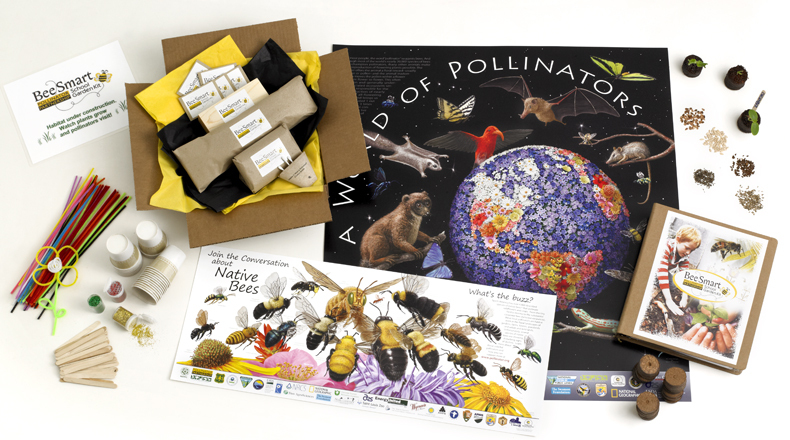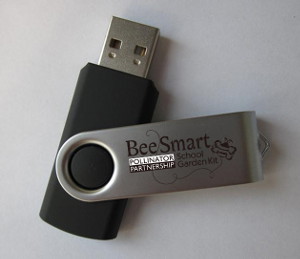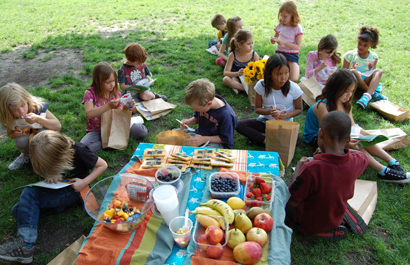Introduction
Our goal is to support teachers, administrators, guardians, youth groups, after school programs, amongst others, in guiding students through a discovery process that will increase students’ understanding in science, math, and language arts by connecting them to plants, pollinators, food, and gardens by (potentially) creating habitat for pollinators. We say “potentially” because building a school habitat garden requires a real commitment. Planting the garden habitat is relatively easy, but making it grow, thrive, and survive several seasons is a commitment and a challenge.
We believe that getting children outside and into the garden is the most valuable part of this experience. But we are also realistic and we urge you to be, too.
More than anything, we want you to use the Bee Smart® School Garden Kit to help expose your students to new ideas about food, wildlife, and plants. It should also help students choose behaviors that support their own health, the health of the planet, and all its plants and animals. And we want the experience to be one that gives you fun, easy, and effective tools to teach and support your curriculum objectives.
We look forward to a bee-utiful learning experience together!
Overview

The Kit can be approached in 3 ways:
- Using school land to create or augment a garden habitat
- Using other demonstration areas to create or visit garden habitat
- Using only in-classroom lessons and on-line experiences without a garden
Each Kit has components that can be used at school, at home, and online to maximize the learning experience. Although we know a diverse group of schools will be using this Kit, we have included the California School Standards at the end of each Lesson Plan as a point of reference. There will also be recommendations that will help connect community resources to the outdoor classroom.
Target Audience and Goals
We have developed the Bee Smart® School Garden Kit for school administrators, educators, teachers, garden coordinators, and parents for use with students in grades 3 to 6.
The Bee Smart® School Garden Kit Includes:
- Pre- and post-tests
- 10 lesson plans with accompanying reproducible worksheets
- Materials for lesson plan activities
- Reproducible handouts
- Access to additional Bee Smart® School Garden Kit materials on Pollinator Partnership website at www.pollinator.org.
Frequently Asked Questions
- How do I get a Bee Smart® School Garden Kit?
Visit this link:
https://www.pollinator.org/bee-smart#order - Do we ship outside of the U.S.? At this time we are only shipping to the United States, within the lower 48, and Canada.
- How long does it take for the package to arrive? Within one month of ordering.
- How will the package be shipped? Priority United States Postal Service.
- Can I rush the delivery of the Kit? Not at this time.
- Can I pay by check? Yes. Send the check with a note included that this is for the Bee Smart School Garden Kit. Make payable and mail to: Pollinator Partnership 582 Market Street, STE 1215
Photo Credits
Special thanks to photographer Marshall Gordon and artist representative Freda Scott for their contribution of Bee Smart® School Garden Kit photographs for use on the P2 website and outreach materials.
Legal
- Disclaimer of Liability: Pollinator Partnership disclaims, and recipients hereby agree to assume, all responsibility and liability for any damages or other harm, whether to recipients or to third-parties, resulting from recipients use of the Bee Smart® School Garden Kit.
- The Bee Smart® School Garden Kit cannot be used for resale or reproduced without permission from Pollinator Partnership.
BeeSmart is a registered trademark of Bee Smart Designs, manufacturers of Ultimate Beekeeping Equipment, and is used with permission.
Order

The School Garden Kit program is sponsored in part by Earth's Ally, an organic pest and weed control company that has committed 5% of it's proceeds to supporting pollinator conservation. Last year, we partnered with Earth's Ally to distribute over 100 complimentary School Garden Kits to classrooms across the country, and are excited to relaunch our partnership this year. Please visit the Earth's Ally website to learn more!
Order a Kit
*Please note - kits are only available to ship in US within the lower 48*
Binder Curriculum: By donating $175 USD to Pollinator Partnership you, or a designated school, will receive 1 school garden kit with color printed curriculum. $50 of the total is tax-deductible as a donation to our work as a 501 (c)(3) non profit. It is tax-deductible to the full extent allowed by law.
Digital Curriculum: By donating $85 USD to Pollinator Partnership you, or a designated school, will receive 1 school garden kit with digital curriculum. $20 of the total is tax-deductible as a donation to our work as a 501 (c)(3) non profit. It is tax-deductible to the full extent allowed by law.
Order School Garden Kit (United States)Order School Garden Kit (Canada)


The kit with digital curriculum includes everything above except for the printed curriculum. Instead you will receive the lesson plans on a USB drive.
Fun

Discover fun ways kids can learn about the importance of pollinators!
- Bloom Bingo
- Crossword Puzzles
- Pollinator Friendly Cookbook
- Vocabulary List
- Word Problems
- Posters, books, brochures, etc.
Answer Keys
Gardens
Building a strong garden team.
The Student Team
Students should participate in all aspects of the garden. They will gain a sense of purpose, accomplishment, and ownership of the garden by being part of the maintenance effort. Group students in pairs or threes and assign each team a specific task. This kind of team focus should be organized before leaving the classroom for a garden visit. Teams can each be doing jobs such as “Pollinator Observation,” “Harvesting” “Watering,” and “Unintended Plant Removal (weeding),” etc.
The Garden Coordinator
Ideally, the Garden Coordinator will be a paid position (if your school’s budget can afford it), or it can be a voluntary part of a staff position or an interested caregiver. Whoever it is, the Garden Coordinator plays a key role in successful school gardens. This is the person who either recruits volunteers or arranges for garden preparation, plant, soil and seed delivery, planting days, maintenance schedule, and harvest.
The characteristics most critical for this position are that the person be well-organized, friendly, willing to get dirty, and work hard. Sound like a tough role to fill? That actually depends on your school and your situation. Remember our maxim – start small and only grow as need demands. It is far better to have a small garden that is well used and starts building enthusiasm in the classroom than to have an overly ambitious project that exhausts your support team. Be sure to encourage conversations with your school’s landscape crew.
The Summer Team
As you work to establish your school’s new garden, don’t forget to ask for help before school lets out for the summer. Ask families to each sign up for a week of garden duty during the summer. Most weeks, they will need to visit the garden once to check if anything has been disturbed in the garden by animal or man, if the irrigation is working properly, and to harvest any produce that may have come in. If your garden is hand irrigated, families will need to stop by more frequently. Many families look forward to their garden week. Most do it in the early morning and enjoy their time together working with the plants. As the temperature dictates, watering in the morning and evening may be necessary.
Pesticide Education
What is a Pesticide? A pesticide is a substance used to control unwanted plants, insect pests, rodents, or plant diseases. Pesticides include herbicides, insecticides, rodenticides, and fungicides. Of the pesticides, we believe insecticides cause the greatest challenge to pollinators. However, using proper application practices when applying any pesticide is very important in keeping people safe, too!
Children and Pesticides Children are disproportionally affected by exposure to pesticides due to their rapid metabolism rate and high hand-to-mouth contact. Children often play in and around areas with pests and treated with pesticides, such as playgrounds and gardens. Integrated Pest Management Integrated Pest Management (IPM) is a collection of pest control practices that uses a suite of tools and reduces dependence on pesticides. IPM principles and practices can be applied both inside school buildings and throughout school grounds. IPM includes regular monitoring for early pest detection, taking action against pests only when necessary, choosing the most effective option with the least amount of risk, and applying biological principles to create lasting solutions.
IPM in School Gardens Using the IPM guiding principles of knowledge, monitoring, least-toxic options, and continuous improvement, schools often save money and improve health by employing a few of the example IPM solutions below to keep pollinators and people safe:
- Where possible, avoid pest problems in the first place by burying infested plant residues, removing pest habitat, and planting disease and pest-resistant plant varieties.
- Carefully diagnose your pest problem, and, before you apply a pesticide, make sure the pest population has reached a level where control is necessary.
- Carefully evaluate your pest control options, and use a combination of pest control techniques if appropriate – these may include beneficial insects, manual removal, traps, a pesticide, etc.
- Plant native flowering plant species to support pollinators, choosing species that are naturally resistant to insect pests.
- Many native pollinators such as bumble bees live in natural areas and also play an essential role in pollination. Be especially careful when trying to control pests in or near these areas. All butterflies start life as caterpillars, feeding on plants. Learn what type of insect is eating your plants before you inadvertently kill butterflies and other beautiful and beneficial insects.
While the steps above can reduce student and staff exposure to toxic agents, the best way to ensure that the school grounds are healthy is through the IPM Start Certification process.
IPM Star Certification for Schools IPM improves pest management results and reduces liability and risks from both pests and pesticides. IPM STAR certification is a voluntary process that establishes your school’s commitment to health and safety.
By working towards and achieving IPM Certification, your school will:
- Establish a formal IPM program
- Receive feedback from an IPM professional;
- Build a professional image and create goodwill; and
- Create long-term, sustainable focus on pest and pesticide risk reduction, ensuring that your school continues to improve.
For more information about pesticide safety, visit the IPM Star Program website (http://www.ipminstitute.org/ipmstar.htm)
Bee Sting Information How to Avoid Getting Stung
- Avoid wearing brightly colored or patterned clothing
- Avoid walking barefoot
- Avoid perfume or cologne when heading to a heavy bee area
- Avoid sudden movements
- Avoid leaving food goods, especially sweets, exposed
If You Get Stung Most allergic reactions to bee stings include pain, and red swelling around the sting. Other common reactions include hives, nausea, dizziness, and a tight feeling in the throat. If these symptoms occur, the person needs medical attention immediately.
Resources
- National Gardening Association (http://www.garden.org/)
- California School Garden Network (http://www.csgn.org/)
- Growing Schools (http://www.growingschools.org.uk/)
- IPM Star Program (http://www.ipminstitute.org/ipmstar.htm)
- Cornell University Department of Horticulture (http://www.gardening.cornell.edu/)
- U.S. Fish and Wildlife Service Schoolyard Habitat (http://www.fws.gov/cno/conservation/schoolyard.cfm)
- The Edible School Project (http://www.edibleschoolyard.org/#)
- American Community Garden Association (http://communitygarden.org/index.php)
- Monarch Watch (http://www.monarchwatch.org/waystations/)
Educators

The Bee Smart™ School Garden Kit is a great tool to teach your students about the importance of pollinators and how they are connected to our food and environment!
Additional Useful Resources
- Nature's Partners: A Comprehensive Pollinator Curriculum for Grades 3-6
- Pollinator Partnership's Pollinator Gardening Curriculum
- The Great Pollinator Partnership lesson ideas
- National Academies Resources on Pollinators
- U.S. Fish and Wildlife Service Schoolyard Habitat Project Guide
- Pollinator Live - Find a series of live interactive webcasts, satellite field trips, and web seminars about pollinators, gardening, and conservation. PollinatorLIVE is geared to grades 4 to 8.
- Discovery Education Pollination Idea- Butterflies Lesson Plans and Plant Pollination Lesson Plans
- Monarch Butterfly Conservation Talking Points
- Powerpoint Presentations for Teaching from Michigan State UniversityAttracting Beneficial Insects with Native Flowering Plants
- http://www.naaee.net/
- http://www.neefusa.org/
Refill your Kit:
The bees and the Pollinator Partnership team greatly appreciate your efforts to foster students through this exciting discovery process. In order to continue exposing students to pollinator-related topics in a hands-on manner, you will need to supplement your existing Bee Smart™ School Garden Kit curriculum with refill materials. Although the curriculum is copyrighted, do not hesitate to share it with other educators at your institution. Please have them order a refill kit to supplement the curriculum. The refill contents include:
- 1 cornmeal bag
- 100 pipe-cleaners
- 1 Bee Tube Nest
- 30 small paper cups
- 1 educator’s dissection seed
- 30 peat pods
- 30 cucumber seeds
- 30 wooden plant makers
- 15 milkweed seeds specific to your ecoregion
- 30 prairie coneflower seeds
- 30 purple coneflower seeds
- 3 cotton swabs
Order a refill for your kit by donation of $50 USD / $65 CAD below:
Order Refill Kit
